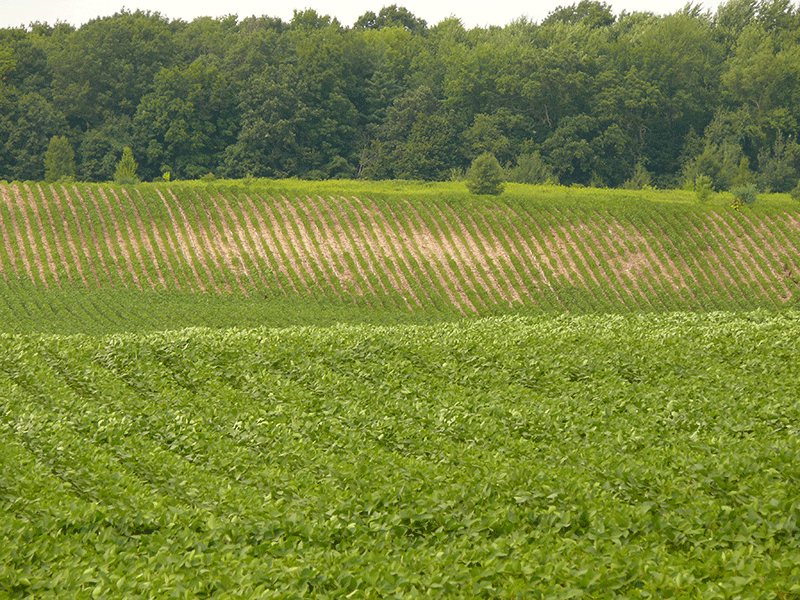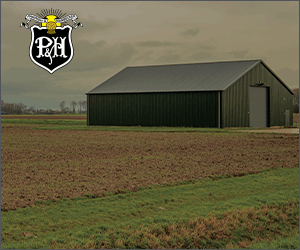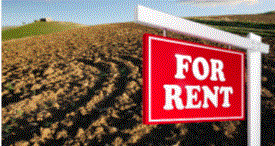Make it stay
STRATEGIES FOR REDUCING SOIL MOVEMENT
DRIVING PAST ROLLING Ontario farm landscapes in the fall, Peter Johnson, agronomist for RealAgriculture.com, can see the soil changing colour on some fields.
PHOTO: ON ROLLING TOPOGRAPHY, TILLAGE EROSION CAN BE GREATER THAN BOTH WATER AND WIND EROSION COMBINED.

That soil isn’t hailing a change in seasons, as it shifts from a rich, deep black to a yellow, red or brilliant, pure white. Rather, it’s a sign that erosion damage has taken place over time.
Understanding the forces at work that cause erosion is the first step in farmers curtailing the issue across Ontario’s farm land.
WIND, WATER, TILLAGE
When one thinks about the forces that cause erosion, wind is what quickly comes to mind.
“Wind erosion can have some major ramifications, but typically you don’t see it every year and you don’t think of it at harvest, because nothing’s moving then. It’s only during that point in the year when the soil is exposed and on lighter soil types where you get it,” says Johnson.
Landscapes that have been damaged by water erosion, meanwhile, feature a landscape that’s been scarred up and down with veiny rills and deep, chasm-like gullies.
However, some of the more serious erosion out there isn’t caused by wind or water but by some tillage practices.
“It honestly comes as a big surprise to most people,” says Johnson, who points out that on rolling topography, tillage erosion can be greater than both water and wind erosion combined.
MOVING TOPSOIL
Tillage erosion takes place when soil is moved — by tillage and cultivation equipment — downslope into lower-lying areas of the fields. What this process does is scrape hilltops, leaving behind a light brown, tan, or even white soil that is missing the rich organic top layer.
Johnson says the speed you travel over your land, not just the type of tillage equipment is often a main factor in determining the impact on erosion.
“The problem isn’t necessarily created by the moldboard plow,” he says. “But when I come in the following spring with the cultivator and I’ve got to get that seed into the ground, I’m pulling that cultivator at seven or eight miles an hour and I go over that field two or maybe three times.” That can move a lot of soil.
Dr. David Lobb, a professor in the Department of Soil Science at the University of Manitoba, who used Johnson’s farm as a site for his master’s thesis, says up until recently, tillage wasn’t considered by many experts to be a major cause of soil erosion, however Lobb’s research found that soil was being moved up to 10 times as far down the slope as it was up the slope by the speed and momentum of tillage and planting equipment.
“Growers that are doing conventional tillage — unless they’re trying to manage soil movement — they’re going to be causing lots of tillage erosion,” he says.
REVERSING LOSSES
The good news is that not only is this movement of soil avoidable, but it’s also reversible.
Tillage erosion eventually leads to is a highly variable field where overall yields are reduced. Those degraded lands will eventually get worse, especially when you factor in unpredictable weather events.
But unlike wind or water erosion, which generally carry away soil from the field and destroy it, the good news about tillage erosion is that the soil is still nearby and completely intact. Lobb says in many Ontario fields, you can often find two to three feet of soil at the bottoms of slopes where topsoil has accumulated. This creates an opportunity for growers to perform a process called soil-landscape restoration.
Soil-landscape restoration is about picking up soil from lower-lying areas of the field and then dumping that soil back on hilltops where it’s been lost.
“That soil you’re moving back onto the hilltop is organic rich, has lots of microbial activity — so it doesn’t take a whole lot, maybe two or three inches, on those upper hilltops for yields to bounce back and the benefits can be pretty immediate,” he says.
Studies show that yields on hilltops can recover the costs of this restoration in as little as four to five years.
CHANGING IMPLEMENTS
In terms of reducing the damage caused by tillage, or other practices, such as harrowing or seeding, Lobb says growers need to consider moving to smaller or flexible frame equipment and slow down as they pass through their fields, to maintain a more uniform speed.
Equipment aside, Lobb says growers need to think big-picture about what they can realistically do to reduce erosion while increasing their overall productivity.
“If you look at all parts of your field as being equally important and you manage it through soil-landscape restoration, or increasing biomass and crop growth, you’re going to end up with better soil water characteristics, and fewer problems with erosion and runoff,” he explains.
SOIL CARE
David Lobb’s father, Don Lobb, an internationally recognized soil conservation expert, researcher and no-till pioneer, says that soil organic matter and biota are central to creating soil aggregates — the binding agents that make the soil structure stable and form the first line of defence against the forces of wind and water erosion.
“Most of your soil life is in that top two to four inches and need those aggregates to bind everything together,” he says.
Don Lobb says that disturbing only about 25 per cent soil surface — as opposed to full-surface tillage — would allow soil aggregates to be created and preserved. Planting cover crops, such as red clover, can also help soil health by boosting the amount of organic content.
“I think ‘soil conservation’ is a term that’s been looked upon as being a little too idealistic. I prefer to talk about soil care. Care puts the emphasis where it should be: looking after the soil,” he says.
To that end, Ontario farmers are making great strides in soil care, as they continue to add cover crops into rotation, adopt strip-tillage and reduced tillage practices, and keep soil health and quality top of mind. •























